Tag: Bancroft
In Memory of Ruth Bancroft 9/2/1908 – 11/26/2017

UC Berkeley alumna Ruth Petersson Bancroft, founder of The Ruth Bancroft Garden in Walnut Creek and well-known expert in dry gardening, passed away at the age of 109 on Nov. 26. Her oral history, The Ruth Bancroft Garden in Walnut Creek, California: Creation in 1971 and Conservation, conducted in 1991 and 1992, is described by interviewer Suzanne B. Riess as “…the amazing chronicle of the growth of a passionate gardener, from her childhood recollections of spring wildflowers on the hills of an earlier, bucolic Berkeley, to her current triumphs, and the tribulations of stewardship of a garden more or less in the public trust.”
The daughter of first-generation Swedish immigrants, Ruth Petersson was born in Massachusetts, but moved to Berkeley, California when her father landed a professorship at UC Berkeley. Of her childhood, she said, “I spent a lot of time wandering around and also over into Wildcat Canyon, just looking at the wildflowers and I think that’s what started me in the interest of wildflowers…” Although Ruth originally studied architecture as one of the only women in the program at UC Berkeley, the Great Depression hit and so for the sake of job security, she switched her career to education. It was during her time as a teacher of home economics in Merced that she met Philip Bancroft, Jr., the grandson of Hubert Howe Bancroft, whose 60,000-volume book collection began the Bancroft Library. After they married, the couple moved onto the Bancroft Farm in the East Bay. The Bancroft family sold much of their land to the city of Walnut Creek as it expanded over the years. Later, in 1971, Philip Bancroft, Jr. gave the last 3-acre plot of walnut orchards to his wife in order to house her extensive collection of succulents.
Though The Ruth Bancroft Garden now boasts a beautiful display of water-conserving plants, the garden was not without its hardships at the beginning. Just a few months after Bancroft began her garden, a severe freeze in December killed nearly all that she had planted. Still, she persevered. “Well, I started again the next year… I figured it doesn’t happen that often, and you can’t just not replant those same things, because they might have another twenty years before they’d be killed again. So I’m just replanting. Have to start over again.” To this, Riess queried, “You didn’t think in some way you had been given a message?” Bancroft laughed and replied, “No.”
A long-time friend of Bancroft and former manager at the UC Berkeley Botanical Garden, Wayne Roderick said, “I would classify Ruth as a genuine dirt gardener. She’s out there doing things with her bare hands. She would be out in the garden by seven at the latest, and for the first hour she was weeding the path of the little spotted spurge, hand-weeding those paths until her knees would get so sore from the rocks, the gravel. That’s what I mean by a genuine dirt gardener.” In addition to Bancroft’s hands-on style of working, she also kept meticulous records as she created her garden. An invaluable addition to her oral history is the transcription of the entirety of her handwritten notes on the garden’s first year, cataloguing every trial and triumph. Riess urges in her introduction to the oral history, “Any gardener will do well to read that year of Ruth’s journal, to see the value of a journal, as well as the work involved in realizing a dream, and the necessity of being willing to weed!”
Over the years, Bancroft also had many helpers that contributed to the development of her impressive creation, such as Lester Hawkins, who created the original design of the garden, and her husband Philip. Roderick recalls, “Phil Bancroft just adored Ruth, and he wanted her to have anything she wanted. He did everything he could to help her. I don’t think Phil thought about the garden continuing, but he certainly was there to make sure she got what she wanted for the place. He was a farmer-type, but he enjoyed seeing the garden, and he was willing to get in and help.” Later, her garden would inspire fellow gardener Francis Cabot to create the Garden Conservancy, of which the Ruth Bancroft Garden became the first of many private gardens to be preserved for the public.
Still, through all of the international recognition and acclaim she received, Bancroft maintained a simple and genuine love for gardening: “You never know just what’s going to bloom when, during the summer. And a lot of the bloom just lasts a day, or possibly two days. It’s interesting to see what there is, and catch it before it’s gone.” When asked whether she had had a mission for the garden, she replied, “I just started it for the fun of it, and the enjoyment of it. I had no idea that people would be looking at it, no idea at all.“
Maggie Deng
Oral History Center Student Assistant
Announcing the Release of the California / San Francisco Fire Departments Oral History Project
The world of firefighting is much more than masked people in uniforms running into burning buildings and rescuing scared cats from trees. While the bravery of firefighters can’t be overestimated, they also work in a complex system that requires constant training and education, a cohesive partnership with local government, extensive procedures and protocols, managerial oversight, effective communication within departments and to the public, acute familiarity with the local and regional environment, and a whole lot of administrative work. The San Francisco Fire Department (SFFD) is a shining example of how people make a civil service operation run and keep people safe. All of these elements, as well as the historic and cultural aspects of the department, are why we chose it as our focus for our California Fire Departments Oral History Project.
The project was originally conceived by Sarah Wheelock, an independent researcher. She wanted to explore several major thematic areas of firefighting in California and she worked with the Oral History Center to do just that. With great sadness we learned that Sarah passed away in 2014 and thus she was unable to see the project through to completion. Taking over the project in 2016, I wanted to honor her original plan and cover the themes that she had outlined. So, I decided to embark on interviews within one department – the SFFD – to document the ways in which they have handled urban fire, climate change, diversity, technological change, and changing demographics.
The SFFD was founded in 1849 and was run by volunteers. It became a paid department, officially integrated into city government, in 1866. The 150th anniversary of the paid department was in 2016, when I was conducting interviews. Given my budget for the project, I was able to interview six people who worked with the SFFD in different capacities. I wanted to include multiple perspectives to understand the organizational, cultural, geographic, economic, and political systems of one of the oldest departments in the country.
The individuals who I interviewed were able to illustrate many of the themes that I wanted to document, and much more. Among the six people I interviewed were Chief Robert Demmons (the first and only African American chief of the SFFD who instrumental in integrating more more women and people of color into the SFFD), Bill Koenig (longtime firefighter and co-founder of Guardians of the City and the SFFD Museum), Jim Lee (also a longtime firefighter and co-founder of Guardians of the City and the SFFD Museum), Steve Nakajo (member of the SFFD Fire Commission), Lt. Anne Young (one of the first females hired), and Jonathan Baxter (longtime paramedic and current Public Information Officer).
These interviews work in concert to illustrate day-to-day operations in the stations, administrative duties, how the city of San Francisco and the department work together, the relationship between paramedics and the department, training, equipment, fire science school, the role of unions, the challenges and triumphs of integrating the departments, the public perception of the department, the role of innovation and changing technology, cultural changes in the department, challenges in fire safety particular to the geography of San Francisco, and the hopes for the future of the SFFD.
It is with great excitement that we present the California / San Francisco Fire Departments Oral History Project. I want to give a special thanks to all of the narrators for sharing their stories with me and helping me to document one of the most historically significant fire departments in our country.
This project is dedicated to the memory of Sarah Wheelock. Her California Firefighter oral histories from the 2000s will be released in early 2018.
From the Oral History Center Director – OHC and Education
For an office that does not offer catalog-listed courses, the Oral History Center is still deeply invested in — and engaged with — the teaching mission of the university.
For over 15 years, our signature educational program has been our annual Advanced Oral History Summer Institute. Started by OHC interviewer emeritus Lisa Rubens in 2002 and now headed up by staff historian Shanna Farrell, this week-long seminar attracts about 40 scholars every year. Past attendees have come from most states in the union and internationally too — from Ireland and South Korea, Argentina and Japan, Australia and Finland. The Summer Institute, applications for which are now being accepted, follows the life cycle of the interview, with individual days devoted to topics such as “Project Planning” and “Analysis and Interpretation.”
In 2015 we launched the Introduction to Oral History Workshop, which was created with the novice oral historian in mind, or individuals who simply wanted to learn a bit more about the methodology but didn’t necessarily have a big project to undertake. Since then, a diverse group of undergraduate students, attorneys, authors, psychologists, genealogists, park rangers, and more have attended the annual workshop. This year’s workshop will be held on Saturday February 3rd and registration is now open.
In addition to these formal, regularly scheduled events, OHC historians and staff often speak to community organizations, local historical societies, student groups, and undergraduate and graduate research seminars. If you’d like to learn more about what we do at the Center and about oral history in general, please drop us a note!

In recent years we have had the opportunity to work closely with a small group of Berkeley undergrads: our student employees. Although the Center has employed students for many decades, only in the past few years have they come to play such an integral role in and make such important contributions to our core activities. Students assist with the production of transcripts, including entering narrator corrections and writing tables of contents; they work alongside David Dunham, our lead technologist, in creating metadata for interviews and editing oral history audio and video; and they partner with interviewers to conduct background research into our narrators and the topics we interview them about. With these contributions, students have helped the Center in very real, measurable ways, most importantly by enabling an increase in productivity: the past few years have been some of the most productive in terms of hours of interviews conducted in the Center’s history. We also like to think that by providing students with intellectually challenging, real-world assignments, we are contributing to their overall educational experience too.
As 2017 draws to a close, I join my Oral History Center colleagues Paul Burnett, David Dunham, Shanna Farrell, and Todd Holmes in thanking our amazing student employees: Aamna Haq, Carla Palassian, Hailie O’Bryan, Maggie Deng (who wrote her first contribution to our newsletter this issue), Nidah Khalid, Pilar Montenegro, Vincent Tran, and Marisa Uribe!
Martin Meeker, Charles B. Faulhaber Director of the Oral History Center
COLLECTIONS as CONNECTORS Holdings from Off-Center
by Steven Black, Bancroft Acquisitions
Things fall apart; the center cannot hold;
Mere anarchy is loosed upon the world…
–William Butler Yeats, from “The Second Coming”
As they do in a teeming metropolis, connections occur naturally among collections in libraries and other repositories. These linkages may involve ideas and people, whether by description (cataloging and metadata), archival arrangement, researcher access and review, or, in the case of a new exhibit at The Bancroft Library, by time-shifted serendipity.
“The Summer of Love, from the Collections of The Bancroft Library” fortuitously brings together two representative figures who, in 1967, circled each other warily, but never met.
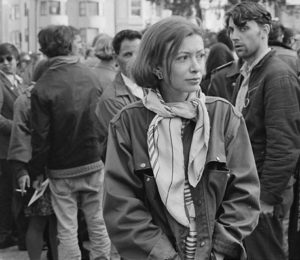
Joan Didion’s reportage in “Slouching Towards Bethlehem” is highlighted in a timely Bancroft exhibition along with images of the hippie scene in San Francisco taken by photographer Ted Streshinsky.
One thread running through her piece (in a reproduction of her typescript essay as submitted for later book publication) is a search for the Communication Company printer and publisher Chester Anderson.
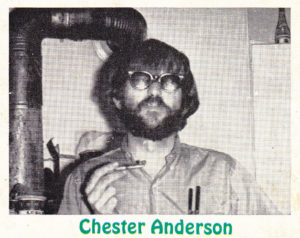
Funded by proceeds from his cult-hit novel The Butterfly Kid (1967), Anderson arrived in the Haight district of San Francisco just as the seeds for the coming “Summer of Love” were sown. In January 1967 he purchased a state-of-the-art mimeograph machine from Gestetner “to provide quick & inexpensive printing service for the hip community.”
Among the works issued by this newest member of the Underground Press Syndicate were innumerable Diggers flyers and handbills, a chapbook by Richard Brautigan (All Watched Over By Machines of Loving Grace), revolutionary manifestos, notices for performances, the Invisible Circus, other happenings, and street level public service announcements.
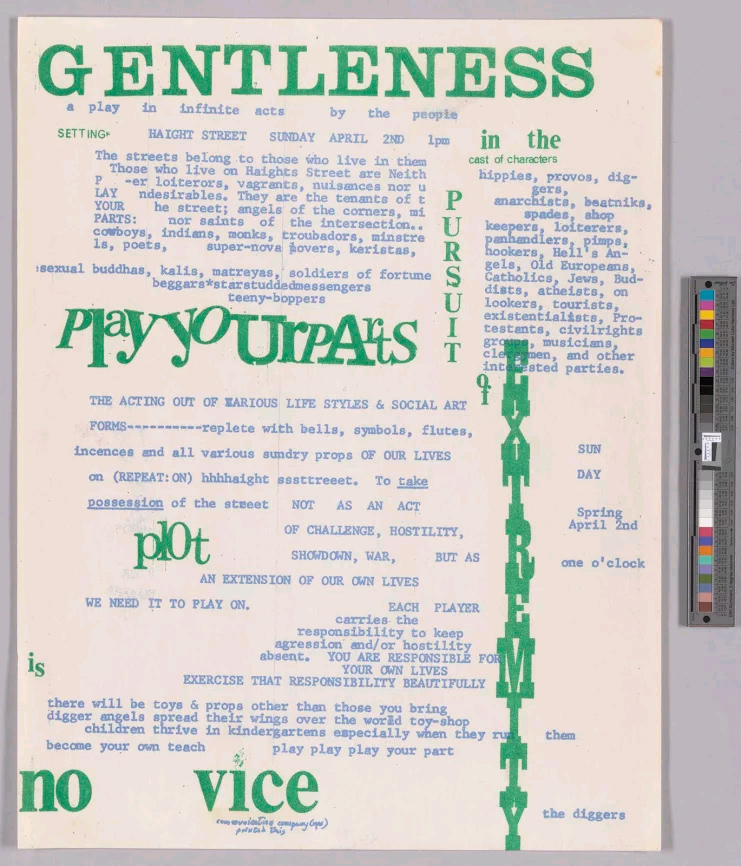
![]() In her quest, Didion describes meeting Com/Co’s co-founder, who (she writes) “says his name is Claude Hayward, but never mind that because I think of him just as The Connection.”
In her quest, Didion describes meeting Com/Co’s co-founder, who (she writes) “says his name is Claude Hayward, but never mind that because I think of him just as The Connection.”
As she is on assignment for a mainstream publication, Didion is considered (in a Diggers phrase-du-jour) to be “a media poisoner.” The Connection urges her to dump the photographer she is with “and get out on the Street” leaving her cash (“You won’t need money”) behind.
Responding to her request to speak directly with Chester Anderson, The Connection says: “If we decide to get in touch with you at all, we’ll get in touch with you real quick.” Although she crosses paths with The Connection again that spring in the Panhandle during an agitprop intervention by the San Francisco Mime Troupe, his passive refusal to hook her up rebuts his street-inflected nickname.
Joan Didion was unable to find the oracular man who could ostensibly help her understand “the scene,” or genius loci. Despite this missed connection with Chester Anderson, by detailing her forays into the Haight-Ashbury and other hippie enclaves around San Francisco, Didion captured in prose a time in violent flux. “Slouching” became the title essay of her celebrated first book of non-fiction, securing her reputation as a caustic and insightful social seismograph.
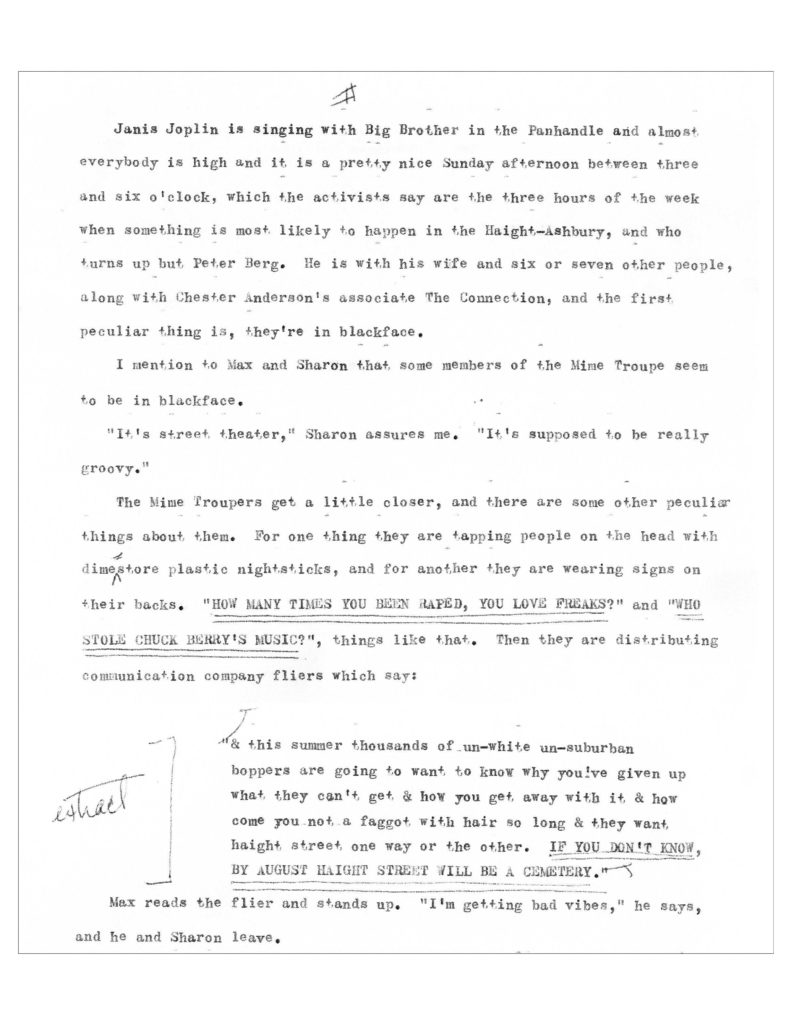
Today their works are co-located in Bancroft’s Summer of Love retrospective: two radically different writers can be seen in a long-delayed meeting that eluded them in real life.
* * *
Provenance notes:
Joan Didion (1934-) Joan Didion’s manuscript (BANC MSS 81/140 c carton 1) came to The Bancroft Library as a gift of the author.
Chester Valentine John Anderson (1932-1991) Chester Anderson’s papers (BANC MSS 92/839 c) came to The Bancroft Library via friend and fellow underground journalist Paul Williams.
Paul Williams (1948-2013) founded Crawdaddy, the first zine of rock and roll journalism (predating Rolling Stone), authored many works of hippie (Apple Bay: or, Life on the planet) and new age journalism (Das Energi), books on Bob Dylan and Philip K. Dick (whose literary executor he was, for close to 20 years). Through his imprint Entwhistle Books, he published two books by Chester Anderson: Fox & hare : the story of a Friday night (f PS3551.N358 F6 1980 Bancroft) and Puppies (p PS3572.A395 P9 1979 Bancroft) under Anderson’s pseudonym John Valentine.
Ted Streshinsky (1923–2003) Ted Streshinsky’s photo archive (BANC PIC 2004.132) was a gift of his wife Shirley.
Here Today, Gone Tomorrow? The Value in Collecting Social Movement Ephemera
While surveying the Mark Evanoff papers recently during archival processing, it soon became clear that this collection includes a particularly rich array of social movement cultural ephemera about the regional and global environmental impact of the nuclear industry in California. Social movement ephemera is produced in a variety of formats to engage, transform and promote direct action toward a dynamic social cause. The content provides a unique glimpse into a time and place in the life of a socio-political movement and so can be of particular historical importance and value in research and instruction when available.
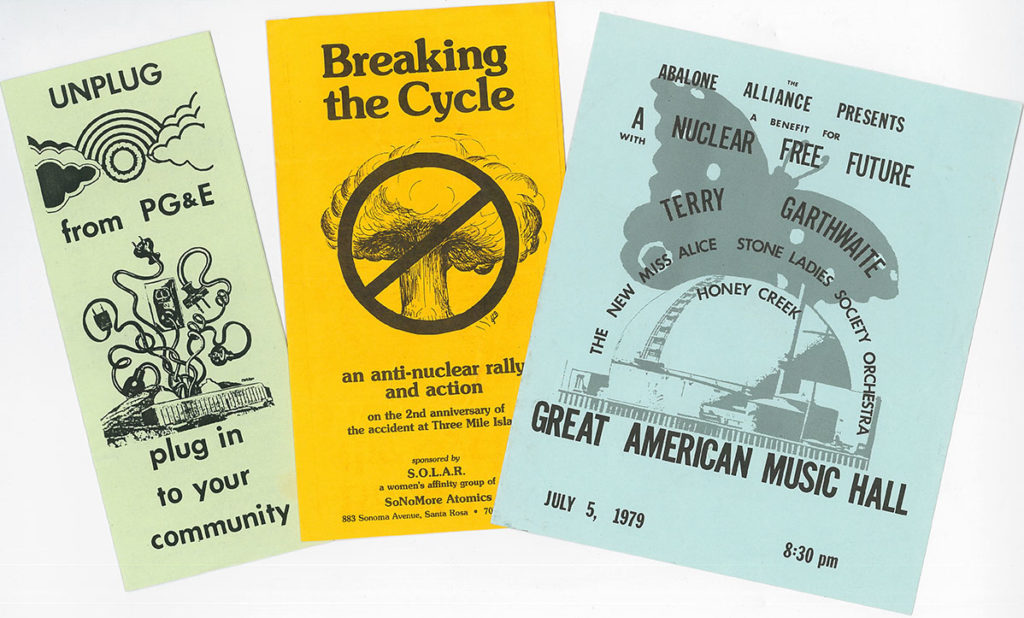
As objects of a temporary nature, ephemera is always at risk of disappearing once its initial purpose has been served. Accordingly, it usually must be saved by a participant or observer around the time of its creation. This is the case with the Mark Evanoff papers. Evanoff worked primarily with the Abalone Alliance and Friends of the Earth during the 1970s and 1980s to oppose the development and operation of nuclear power plants in Diablo Canyon and Humboldt Bay. He wrote articles for Friends of the Earth’s “Not Man Apart” publication, planned and participated in protest actions (and was arrested twice in the Diablo Canyon blockades), mobilized activists and prepared groups for non-violent civil disobedience training and legal defense.

Evanoff also collected and disseminated educational resources about nuclear power and disarmament produced by local and global pro-nuclear and anti-nuclear groups. The Evanoff papers provide substantial evidence of the anti-nuclear movement, community organizing, direct action and social movement participation at a grassroots level during this period through the correspondence, organizing notes, meeting minutes, legal testimony, public policy clippings, and ephemera contained within the collection.
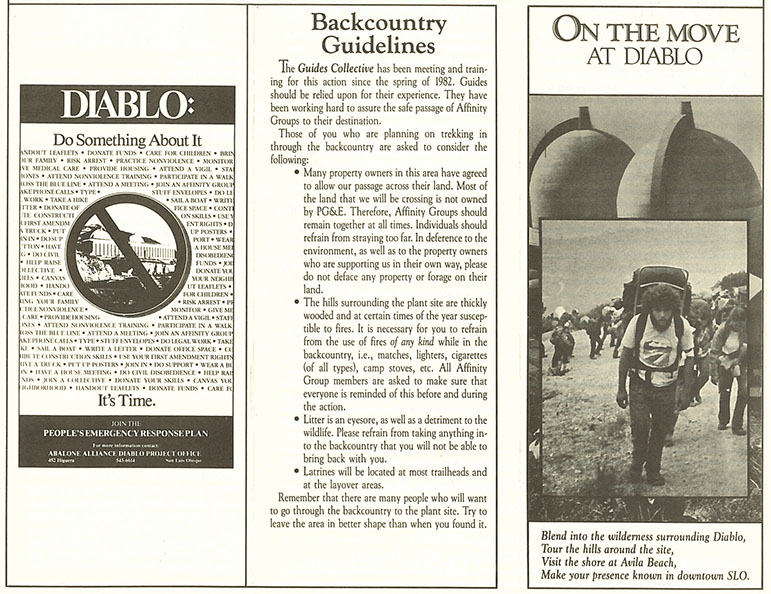
Since adapting to communication trends is crucial in the progress of social movements, the choices made regarding the information, language, graphic design, artwork, printing and distribution of ephemera produced by these groups can profoundly affect the message. With just a few images and well positioned text, effective social movement ephemera opens minds, pulls at the heart-strings, and/or gets the viewer’s blood boiling and ready for action. It acts as a useful educational and marketing outreach tool to share information, promote ideas, publicize an agenda and provide talking points about a cause. Activist ephemera also usually presents logistical details as to the who, what, when, why, where and how of community organizing, grassroots public policy lobbying, protest marches, fund raising concerts and other actions.

Ephemera is most powerful when designed with eye catching, bold, trending or symbolic imagery, visual cues and creative use of text, colors and fonts. Many flier, poster and zine designs have a cut and paste, DIY (Do-It-Yourself) quality: utilizing photographs overlaid with other compelling graphics and text, including well-known historical quotes or humorous catchphrases, and self-published at home or printed at copy stores. While some other ephemera is professionally graphic-designed and printed on finer quality papers.
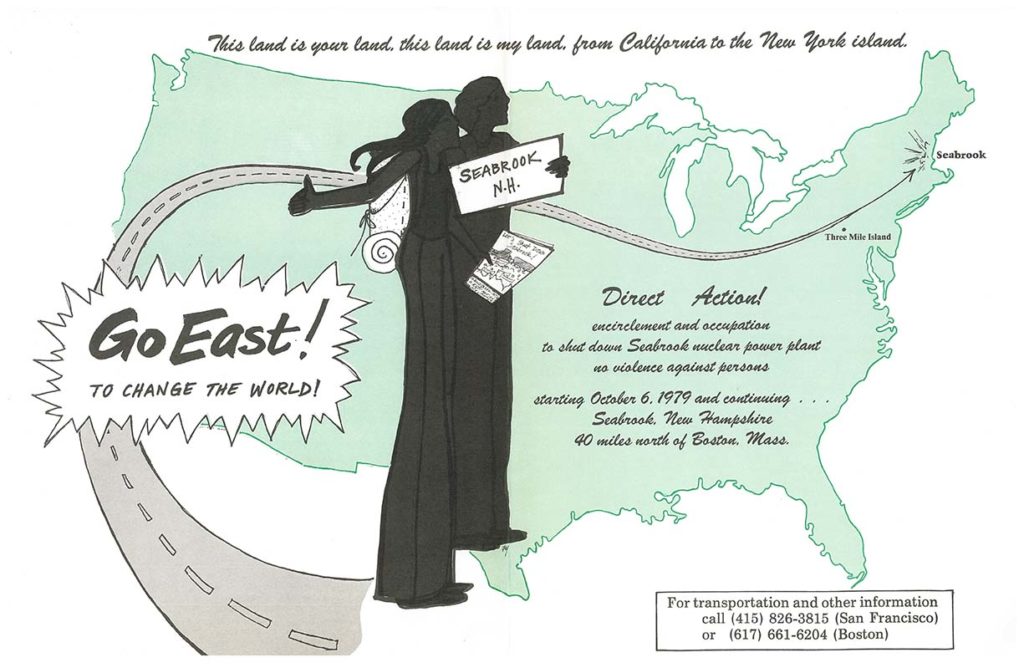
Although some materials are undated and may contain questionably reliable content, requiring additional sleuthing to fact check information and find accurate dates, much cultural ephemera can provide valuable incite to researchers long after the date of creation. Social movement ephemera may also act as a jumping off point for scholarly research when used in exhibitions, publications and instruction. The visual aspects and originality of content of this sort of cultural ephemera has the ability to draw a viewer in to study a topic they otherwise may not have known or thought much about previously.
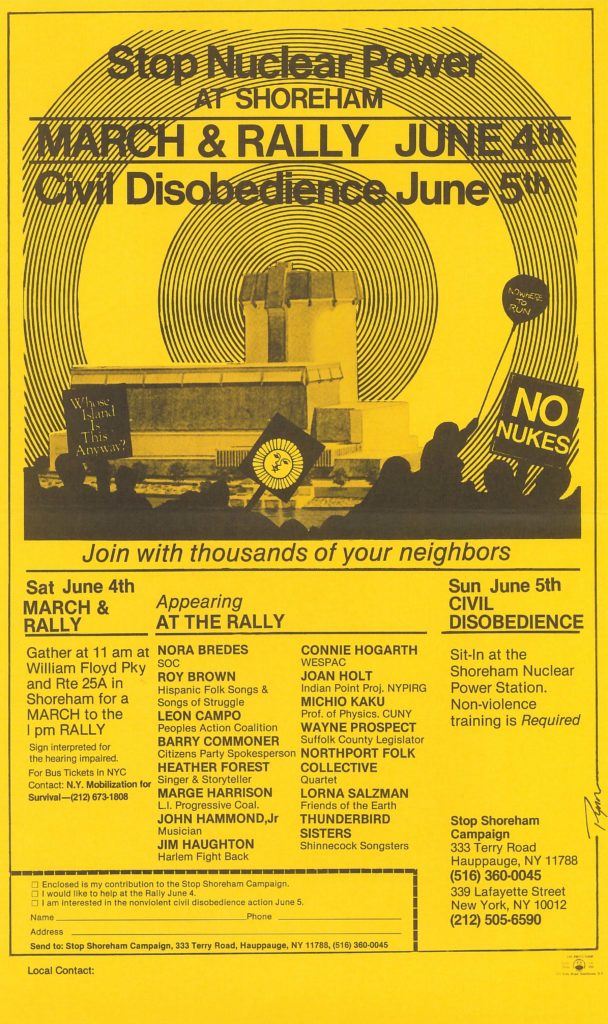
Some of the qualities that make activist ephemera unique can also become challenges when preserving a collection of archival materials. Certain items may be difficult to stabilize and store long-term in their entirety when produced on acidic paper, fabric, metal, plastic or wood; or when they are found adhered to the pages of scrapbooks or attached to handles. There may also be questions as to how best to organize and catalog ephemera materials within a large collection, so that a potential researcher will be able to readily find relevant items. To highlight the research value of the ephemera in the Evanoff papers, it has been arranged so that anti-nuclear materials are separated for the most part from power plant information and nuclear power subject and technical files, and it has been described within the finding aid in a bit more detail than usual.
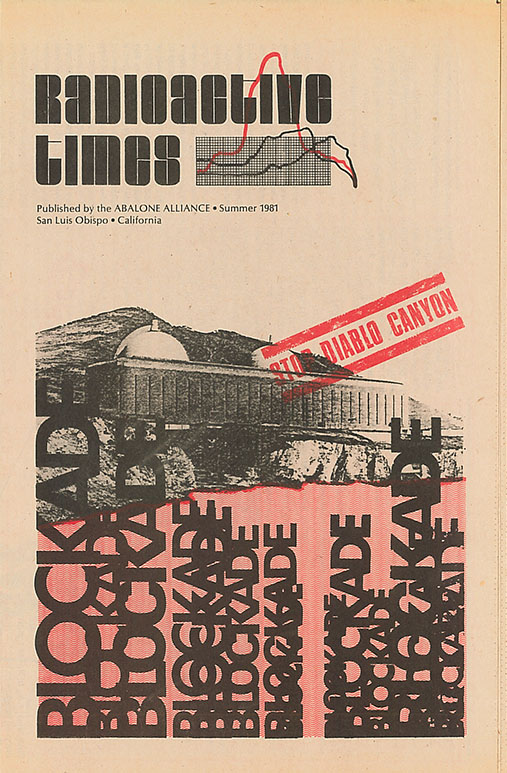
After nearly 60 years of controversy since construction began on the Diablo Canyon Power Plant, PG&E announced plans for its closure in 2025. While it’s impossible to measure the effect that the activist ephemera produced by the Abalone Alliance and other anti-nuclear groups had on this result, it is easy to see the informational, evidential and aesthetic value in keeping these social movement materials for future researchers. What is important to the historians of tomorrow must be collected and saved today.
The Mark Evanoff papers are now processed and open to researchers at The Bancroft Library.
What’s In a Name? How One Bancroft Library Archivist Shed Light on a Gold Rush Era Gem
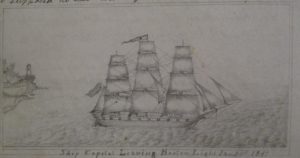
Background: Each year the Bancroft Library acquires a sizeable amount of new manuscript material. The sheer quantity of this material necessitates that the archivists who handle, process, and catalog these materials, exercise considerable judgment in balancing thorough and accurate descriptions that facilitate access with the need to make the materials available as quickly as possible. Archivists are trained to determine just the right level of description to allow for sufficient discovery. In the case of very large collections, an archivist rarely describes materials at the item-level.
But sometimes a single item merits closer examination and considerable research to render it truly accessible to the library’s researchers. One such item recently caught my attention–
The “Ship Capitol’s Log Book” is the account of a passenger aboard one of the first ships to head to California during the gold rush, arriving in San Francisco in July 1849.
At first glance, it looked like a typical gold rush era journal, with daily entries describing conditions and life aboard the ship as it made its way from Boston to San Francisco around Cape Horn. But this one stood out because it included several finely rendered pencil drawings throughout including ships, shorelines, and even an albatross at rest.
Unlike similar journals that have crossed my desk, this one came with a contemporary inscription inside the front cover identifying the ship and giving the date (and, incidentally, providing a neat title for the catalog record). The accompanying description provided by the vendor was also intriguing, noting that there was an additional inscription in a different hand: “Above this [title] is the inscription of Paul Maraspin, another passenger on the ship and the ancestor of the log’s most recent owner…. It is not clear who authored the journal.” However, upon closer examination, I determined that this might not be the case. It was clearly two initials followed by “Maraspin” but it didn’t look like either a “P” or “Paul.” I could not clearly make out the first initial, but the second one looked like an “L,” and below that a street address of “17 Court Street, Boston” and the date “Feb. 1917.”
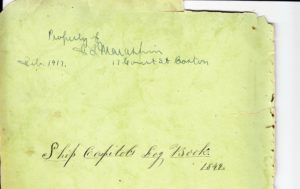
The vendor also noted that the lettering of the captions of the drawings was in a third hand, suggesting that someone other than the author of the journal might be the source of those. Also noted was the composer of several songs recorded in the journal, B.F. Whittemore.
The clues from the vendor and my own initial assessment of the journal suggested that a bit more research might make the journal infinitely more discoverable and useful. I became intrigued by the name of the owner of the journal, and the information suggested by the vendor just didn’t seem to fit with the facts the artifact was presenting to me.
Archivists have at their disposal the same research tools many other people do…the internet and access to genealogical sites that hold various records. There is a tremendous amount of information out there that makes this kind of research much more efficient than it used to be. Of course, too much information can also be problematic and it is the skillful researcher who can quickly sort through large amounts information and surmise whether more research will yield tangible results or, lacking that, have to call the effort “good enough.”
In this particular case, I discovered information about the owner’s signature that led to the solution of numerous puzzles presented by the journal itself, including how he came into possession of it, its likely author, the identity of the illustrator, the history of the lyricist of several songs, the author of the final song in the journal, and the history of the ship and its captain, Thorndike Procter.
Because Maraspin struck me as an unusual name, my first step was a Google search on the name. This resulted in the discovery of a Maraspin Creek in Barnstable, Massachusetts. Assuming the creek was named after a prominent family in the area, the information gave me hope that I could find out more about them and explore those connections.
I switched over to Ancestry.com to do a direct search on Paul Maraspin from Barnstable, Massachusetts around the time period of 1849. Numerous records surfaced that indicated a Paul Maraspin from Barnstable had been married and had several daughters, but none of whose initials matched the inscription in the journal. But then I found an application to the Sons of the American Revolution from 1937 for Paul Maraspin that listed his wife, Mary Eliza Davis, and one child, a son, Francis Lothrop Maraspin. Paul Maraspin had this son rather late in life, at the age of 52, and some 16 years after he had sailed to California. Looking back at the inscription, I could see now that the autograph was, in fact, “F.L. Maraspin.”
I then turned to confirming that this was, indeed, the Francis Lothrop Maraspin in the application form. Back to Google, I found an article from the Cape Cod Times lauding a Francis Maraspin’s 100th birthday in 1966. Back to Ancestry.com I found another Sons of the American Revolution application from 1935, this time for a Francis Lothrop Maraspin. I could see print coming through from the backside of the page and paged forward to see it. Right at the top was the statement identifying Paul Maraspin as his father. But the real clincher was at the bottom.The application was signed by Francis Lothrop Maraspin himself with his typed address, 17 Court Street, Boston.
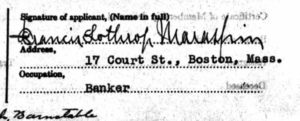
And from the journal again:

As you can see, the signature and address matched the inscription on the journal cover perfectly and we now knew we had our owner and could assume, with reasonable certainty, that the likely author of the journal was Francis Lothrop’s father, Paul Maraspin.
I shared these initial findings with my supervisor, Randal Brandt, who directed me to a publication that would be key to figuring out the rest of the puzzles. The Argonauts of California, published by C.W. Haskins in 1890, is an invaluable source of information about the gold seekers who came to California. The passenger lists it contains were crucial in figuring out the names of people associated with the journal. We now knew who had written the journal but who had done the drawings? And what about the composer of those numerous songs recorded in the journal? A closer examination of the drawings proved fruitful. Of the nine drawings, two of them had the initials “CCH” in the lower right hand corner.
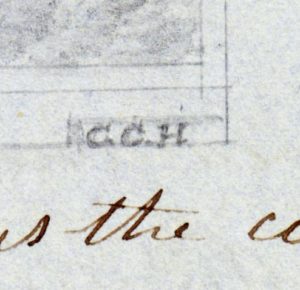
A quick perusal of the Capitol’s passenger list turned up only one possible match, a C.C. Hosmer. Now we knew the name of the illustrator. Back to Ancestry.com again, I went hunting for more information about him and found out his full name, Chester Cooley Hosmer (1823-1879). Because Chester Cooley Hosmer is also an unusual name, on a whim I Googled it along with the word “Capitol.” The very first result was a library catalog listing in the Special Collections of the Jones Library in Amherst, Massachusetts for Chester Cooley Hosmer’s journal documenting the same trip aboard the Capitol. Describing it as a journal “illustrated throughout with his drawings,” the catalog listing included scans of two pages with drawings. Here is one of them.
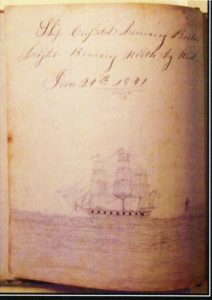
One can readily see the style of these drawings match those in the Maraspin journal. Not only did we now know our illustrator but also the location of his journal from the very same voyage.
Turning to the name listed as the songwriter, B.F. Whittemore (sometimes spelled incorrectly as “Whitmore” in passenger lists), a search turned up another interesting character. The Wikipedia entry for Benjamin Franklin Whittemore states that he went on to become a minister in the Union Army and then elected to the state legislature of South Carolina and eventually the House of Representatives.
Others identified in this process included the composer of the final song lyrics in the journal titled, “A Song Dedicated to the Officers of the Ship Capitol,” and signed “W.T. old friend.” Again, the passenger lists were the key as only one person had those initials, W.T. Hubbard.
More research on the ship and lists revealed the full name of the captain, Thorndike Procter of Salem, Massachusetts.
As might be true with any group of persons traveling so far from home for so long, there is inevitable tragedy as well as triumph. Captain Thorndike Procter committed suicide in San Francisco Bay on October 17, 1849. It was reported in the papers that the captain “had been lately subject to occasional fits of derangement, during the last of which he jumped overboard, and was drowned….” Nine weeks later, Paul Maraspin’s young “old friend,” William.T. Hubbard, just 23 years of age, also died by drowning in San Francisco Bay on Christmas Eve.
The work of improving access and discoverability to our collections is at the heart of what we do as library professionals. Unknown people become known, their stories and lives become real to us, and as you read this journal now you can see the intertwining of their lives. One hundred and sixty-eight years later, two journals from the same trip are virtually reunited because of the work of archivists and catalogers separated by time and a continent. In this way, library professionals contribute to a very large cultural jigsaw puzzle that, slowly but surely, becomes ever more complete.
To see the completed catalog record for this item please use this link:
http://oskicat.berkeley.edu/record=b23750637~S1
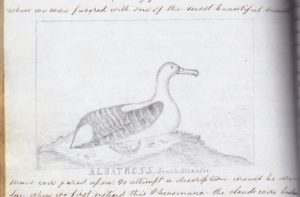
Freedom to Marry Oral History Project
The Freedom to Marry Oral History Project
In the historically swift span of roughly twenty years, support for the freedom to marry for same-sex couples went from an idea a small portion of Americans agreed with to a cause supported by virtually all segments of the population. In 1996, when Gallup conducted its first poll on the question, a seemingly insurmountable 68% of Americans opposed the extension of marriage rights. In a historic reversal, fewer than twenty years later several polls found that over 60% of Americans had come to support the freedom to marry nationwide. The rapid increase in support mirrored the progress in securing the right to marry coast to coast. Before 2004, no state issued marriage licenses to same-sex couples. By spring 2015, thirty-seven states affirmed the freedom to marry for same-sex couples, with a number of states extending marriage through votes in state legislatures or at the ballot box. The discriminatory federal Defense of Marriage Act, passed in 1996, denied legally married same-sex couples the federal protections and responsibilities afforded married different-sex couples—a double-standard corrected when a core portion of the act was overturned by the U.S. Supreme Court in 2013 in United States v. Windsor. The full national resolution came in June 2015 when, in Obergefell v. Hodges, the U.S. Supreme Court ruled that the Constitution’s guarantee of the fundamental right to marry applies equally to same-sex couples.
The Oral History Center is thrilled to release to the public the first major oral history project documenting the vast shift in public opinion about marriage, the consequential reconsideration of our nation’s laws governing marriage, and the actions of individuals and organizations largely responsible for these changes. The Freedom to Marry Oral History Project produced 23 interviews totaling nearly 100 hours of recordings. Interviewees include: Evan Wolfson, founder of Freedom to Marry; Kate Kendell, executive director of the National Center for Lesbian Rights; James Esseks, director of the ACLU’s LGBT & HIV project; and Thalia Zepatos, the movement’s “message guru” who worked at Freedom to Marry as director of research and messaging. Read on for video clips of the interviews and links to complete interview transcripts.
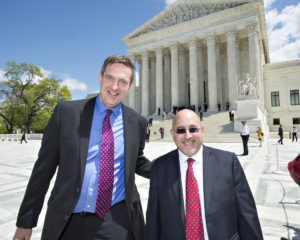
At the center of the effort to change hearts and minds, prevail in the courts and legislatures, win at the ballot, and win at the Supreme Court was Freedom to Marry, the national campaign launched by Harvard-trained attorney Evan Wolfson in 2003. Freedom to Marry’s national strategy focused from the beginning on setting the stage for a nationwide victory at the Supreme Court. Working with national and state organizations and allied individuals and organizations, Freedom to Marry succeeded in building a critical mass of states where same-sex couples could marry and a critical mass of public support in favor of the freedom to marry. This oral history project focuses on the pivotal role played by Freedom to Marry and their closest state and national organizational partners, as they drove the winning strategy and inspired, grew, and leveraged the work of a multitudinous movement.
Freedom to Marry Oral History Project Interview Transcripts:
Barbara Cox, “Barbara Cox on Marriage Law and the Governance of Freedom to Marry.”
Michael Crawford, “Michael Crawford on the Digital Campaign at Freedom to Marry.”
Scott Davenport, “Scott Davenport on Administration and Operations at Freedom to Marry.”
Jo Deutsch, “Jo Deutsch and the Federal Campaign.”
Sean Eldridge, “Sean Eldridge on Politics, Communications, and the Freedom to Marry.”
James Esseks, “James Esseks on the Legal Strategy, the ACLU, and LGBT Legal Organizations.”
Harry Knox, “Harry Knox on the Early Years of Freedom to Marry.”
Matt McTighe, “Matt McTighe on the Marriage Campaigns in Massachusetts and Maine.”
Amy Mello, “Amy Mello and Field Organizing in Freedom to Marry.” (forthcoming)
John Newsome, “John Newsome on And Marriage for All.”
Kevin Nix, “Kevin Nix on Media and Public Relations in the Freedom to Marry Movement.”
Bill Smith, “Bill Smith on Political Operations in the Fight to Win the Freedom to Marry.”
Marc Solomon, “Marc Solomon on Politics and Political Organizing in the Freedom to Marry Movement.” (forthcoming)
Tim Sweeney, “Tim Sweeney on Foundations and the Freedom to Marry Movement.”
Cameron Tolle, “Cameron Tolle on the Digital Campaign at Freedom to Marry.”
Thomas Wheatley, “Thomas Wheatley on Field Organizing with Freedom to Marry.”
Evan Wolfson, “Evan Wolfson on the Leadership of the Freedom to Marry Movement.”
Thalia Zepatos, “Thalia Zepatos on Research and Messaging in Freedom to Marry.”

“The Gift to Sing”: Bancroft exhibit offers tour of African American history and culture
Treasures from legendary professor Leon Litwack’s African American history and culture book collection are on display through February in the Bancroft Library Gallery. Browsing “The Gift to Sing” exhibit offers viewers a chance to revisit milestones in the long journey of African Americans in this country towards full equality, freedom, and cultural expression.
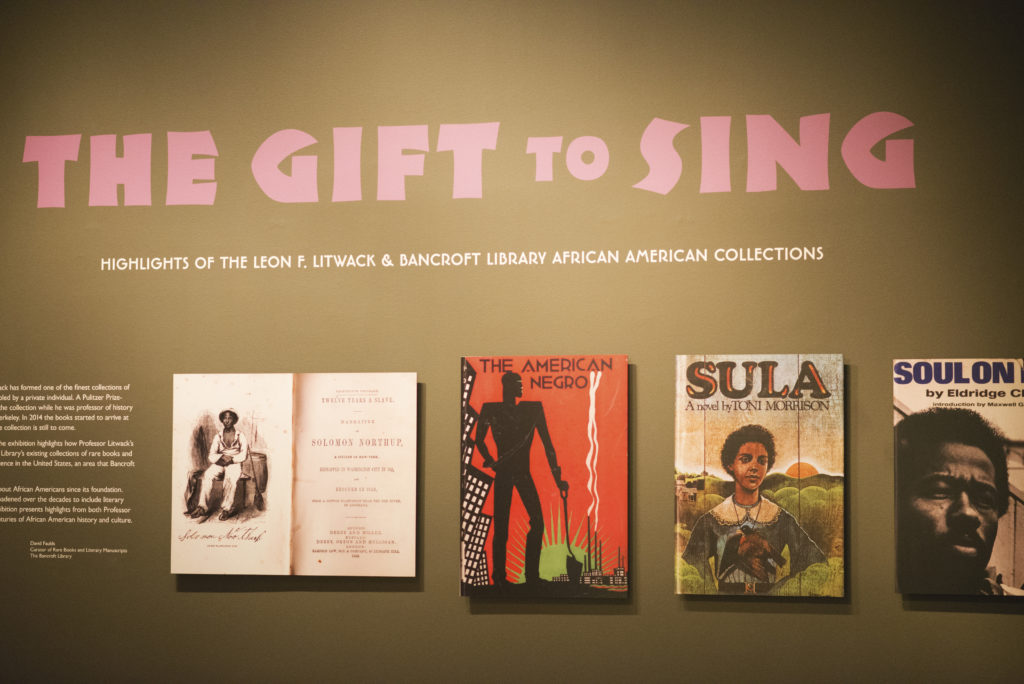
Slave narratives and autobiography, drawings and photography, collections of spirituals, newspapers, novels and poetry, historical and sociological works — all with rich significance outlined in curator David Faulds’ captions — are among the works included.
Litwack’s collection, most of which will come to the Bancroft as a bequest, originated in his teenage years in Santa Barbara in the 1940s, when the young Leon haunted a used bookstore called the Book Den. Langston Hughes volumes purchased then for a dollar or two are on display in the exhibit.
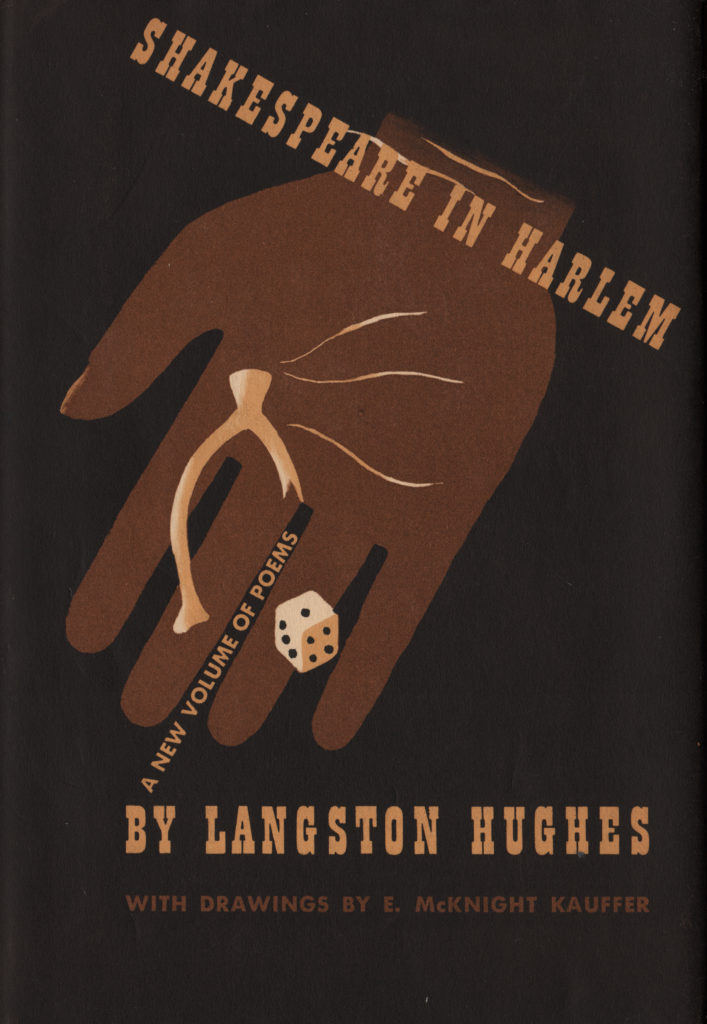
Over six decades of continued collecting later — informed by his celebrated scholarship in African American history and culture — Litwack’s library is considered one of the best in private hands.
On display in the Bancroft exhibit are Harlem Renaissance first editions in strikingly illustrated dust jackets; Bobby Seale’s copy of The Autobiography of Malcolm X, which Litwack had the good fortune to pick up for $5 at Moe’s Bookstore near campus; a copy of Narrative of the Life of Frederick Douglass, an American Slave inscribed by famous abolitionist William Lloyd Garrison; and Ida B. Wells’ rare and important pamphlet on lynching, The Red Record.
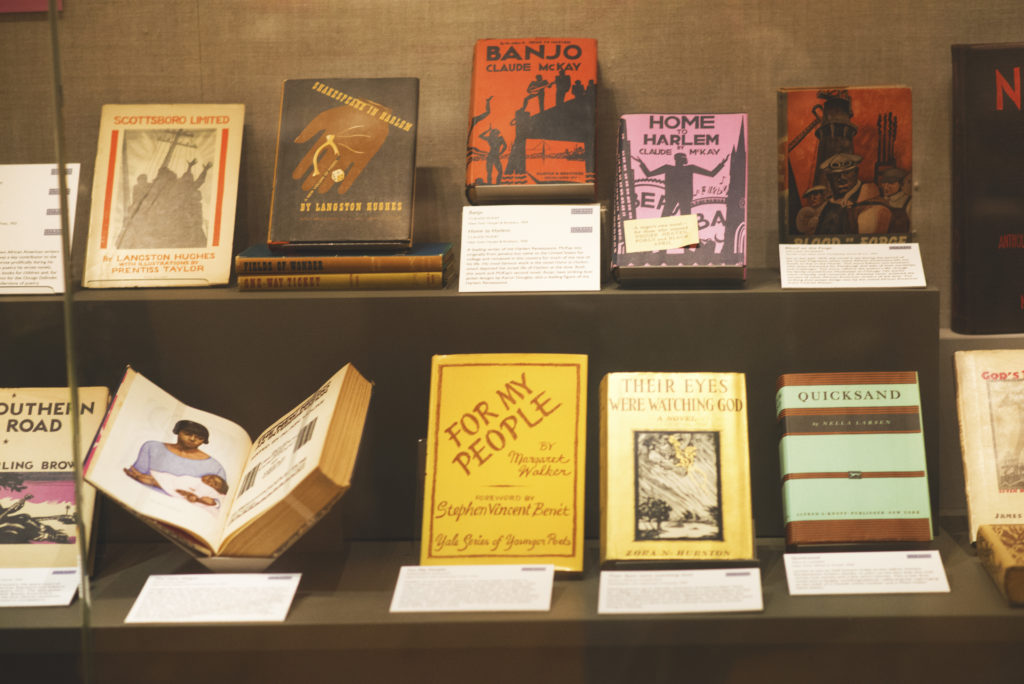
Exhibit visitors can also see the first book by an African American, Phyllis Wheatley’s Poems on Various Subjects, Religious and Moral, which was published in 1773. This edition is one of the treasures from the Bancroft’s current collection which are also exhibited in “The Gift to Sing.”![]()
The exhibit is organized in seven sections including the arts; California, society; literature and history, modern and early 20th century; slave narratives; and racial uplift (1890-1910).
The oldest book in the exhibition dates from 1744 and reports on the execution of thirty blacks and four whites for their role in the Conspiracy of 1741, a supposed insurrection by slaves and poor whites. Like the Salem witch trials, this event is now seen by some scholars as a case of mass hysteria, in which a number of acts of arson were attributed to a criminal conspiracy.
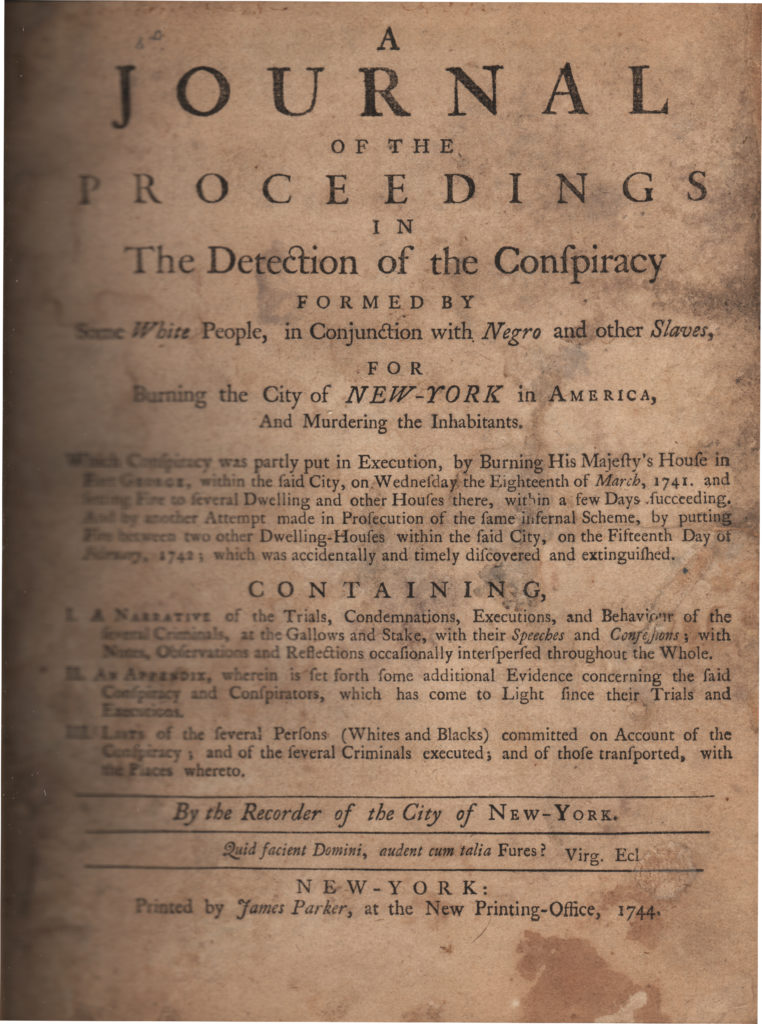
A 1919 history of African Americans in California took shape through research at the Bancroft itself. Author Delilah Beasley spent many years in Bancroft poring over California and black newspapers and archives to research her book.
Less well-known materials are displayed alongside famous items such as the most popular novel of the 19th century — Uncle Tom’s Cabin, the 1852 anti-slavery classic by Harriet Beecher Stowe, and Toni Morrison’s 1987 novel Beloved.
The range and depth of the collection reflects Litwack’s lifelong quest to uncover and to teach the history of race relations in America and the experiences of people long absent from the historical narrative. He has authored four major books and countless articles, and has been awarded the Pulitzer Prize and the National Book Award.
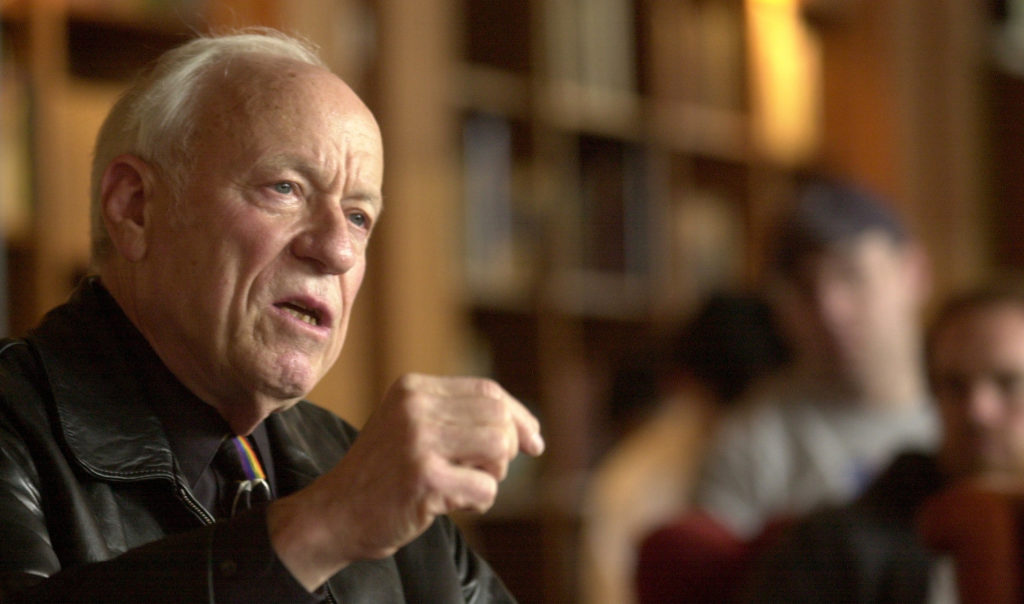
Litwack retired from Berkeley in 2007 after forty-three years. His final lecture on America’s racial divide was entitled “Fight the Power.”
Litwack has long been a passionate advocate for the importance of the Library, an advocacy which dates back to his undergraduate years at Berkeley, starting in 1948. “What I coveted more than anything else was a job in the UC Library,” he said. “And I was fortunate enough to get one . . . That was just fabulous.”
“The Gift to Sing: Highlights of the Leon F. Litwack and Bancroft Library African American Collections” is on display in the Bancroft Library Gallery through February 17, 2017, from 10 am to 4 pm.
Event: Bancroft Library Roundtable: “The Ingenuity of Lillian Gilbreth”
The next Bancroft Library Roundtable will take place in the Lewis-Latimer Room of The Faculty Club at noon on Thursday, November 17. Ferd Leimkuhler, professor emeritus, Purdue University, will present “The Ingenuity of Lillian Gilbreth.”
In 2004 the U. S. Academy of Engineering published its vision of engineering in the new century and concluded that the engineer of 2020 will aspire to have the ingenuity of Lillian Gilbreth, the problem-solving capabilities of Gordon Moore, the scientific insight of Albert Einstein, the creativity of Pablo Picasso, the determination of the Wright brothers, the leadership capabilities of Bill Gates, the conscience of Eleanor Roosevelt, and the vision of Martin Luther King, Jr. The leading person in this distinguished list is UC Berkeley alumna Lillian Moller Gilbreth (Bachelor of Letters, 1900; Master of Letters, 1902; honorary doctorate, 1933, and Outstanding Alumna, 1954). This talk will discuss her ingenuity and the need to remember her bravery in a man’s world.
We hope to see you there.
José Adrián Barragán-Álvarez and Kathi Neal
Bancroft Library Staff
The Library attempts to offer programs in accessible, barrier-free settings. If you require disability-related accommodations, please contact The Bancroft Library at (510) 642-3781 — ideally at least two weeks prior to the event.
Event: Bancroft Library Roundtable: Whose Story Gets Told?
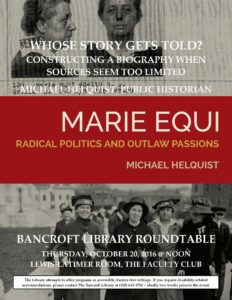 The next Bancroft Roundtable will take place in the Lewis-Latimer Room of The Faculty Club at noon on Thursday, October 20. Michael Helquist, public historian, will present “Whose Story Gets Told? Constructing a Biography When Sources Seem Too Limited.”
The next Bancroft Roundtable will take place in the Lewis-Latimer Room of The Faculty Club at noon on Thursday, October 20. Michael Helquist, public historian, will present “Whose Story Gets Told? Constructing a Biography When Sources Seem Too Limited.”
Public historian Michael Helquist argues that we lose an essential part of our history and a deeper sense of who we are by not knowing the life stories of marginalized people. He includes in that group women, racial minorities, working class and poor people, immigrants, political radicals, and LGBTQ people. His talk will feature an early woman physician and political radical, Marie Equi, who is little known, although she was one of the most prominent activists on the West Coast in the WWI era, a heroine after the 1906 San Francisco earthquake, and one of the first publicly known lesbians on the West Coast. Mr. Helquist will consider why her full story had not been told and will recount his discovery of troves of primary sources. He will present images of Dr. Equi and her life, from working in a textile mill to doing time in San Quentin. His biography, Marie Equi: Radical Politics and Outlaw Passions, published by Oregon State University Press in 2015, was named a 2016 Stonewall Honor Book for Nonfiction by the American Library Association.
We hope to see you there.
José Adrián Barragán-Álvarez and Kathi Neal
Bancroft Library Staff
The Library attempts to offer programs in accessible, barrier-free settings. If you require disability-related accommodations, please contact The Bancroft Library at (510) 642-3781 — ideally at least two weeks prior to the event.